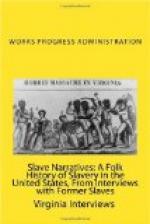On the Coxton plantation all slaves always had a sufficient amount of clothing. These clothes which were issued when needed and not at any certain time included articles for Sunday wear as well as articles for work. Those servants who worked in the “big house” wore practically the same clothes as the master and his wife with the possible exception that it met the qualification of being second-handed. An issue of work clothing included a heavy pair of work shoes called brogans, homespun shirts and a pair of jeans pants. A pair of knitted socks was also included The women wore homespun dresses for their working clothes. For Sunday wear the men were given white cotton shirts and the women white cotton dresses. All clothing was made on the plantation by those women who were too old for field work.
In the same manner that clothing was sufficient, so was food plentiful. At the end of each week each family was given 4 lbs. of meat, 1 peck of meal, and some syrup. Each person in a family was allowed to raise a garden and so they had vegetables whenever they wished to. In addition to this they were allowed to raise chickens, to hunt and to fish. However, none of the food that was secured in any of the ways mentioned above could be sold. When anyone wished to hunt, Mr. Coxton supplied the gun and the shot.
Although the slaves cooked for themselves, their breakfast and dinner were usually sent to them in the fields after it had been prepared in the cook house. The reason for this was that they had to get up too soon in the morning, and at noon too much time would be lost if they were permitted to go to their cabins for lunch.
The children who were too young to work in the field were cared for by some old slave who likewise was unable to do field work. The children were usually fed pot liquor, corn bread, milk, syrup, and vegetables. Each one had his individual cup to eat from. The food on Sunday was usually no different from that of any other day of the week. However, Mr. Bland says that they never had to break in the smokehouse because of hunger.
When asked to describe the living quarters of the slaves on his plantation he looked around his room and muttered: “Dey wuz a lot better than dis one.” Some of the cabins were made of logs and some of weatherboards. The chinks in the walls were sealed with mud. In some instances boards were used on the inside to keep the weather out. There were usually two windows, shutters being used in the place of window panes. The chimney and fireplace were made of mud and stones. All cooking was done at the fireplace as none of them were provided with stoves. Iron cooking utensils were used. To boil food a pot was hung over the fire by means of a hook. The remaining furniture was a bench which served as a chair, and a crude bed. Rope running from side to side served as bed springs. The mattress was made of straw or hay. For lighting purposes, pine knots and candles were used. The slaves on the Coxton plantation were also fortunate in that all cabins had good floors. All cabins and their furnishings were built by the slaves who learned the use of hammer and saw from white artisans whom Mr. Coxton employed from time to time. Mr. Bland remarked that his father was a blacksmith, having learned the trade in this manner.




